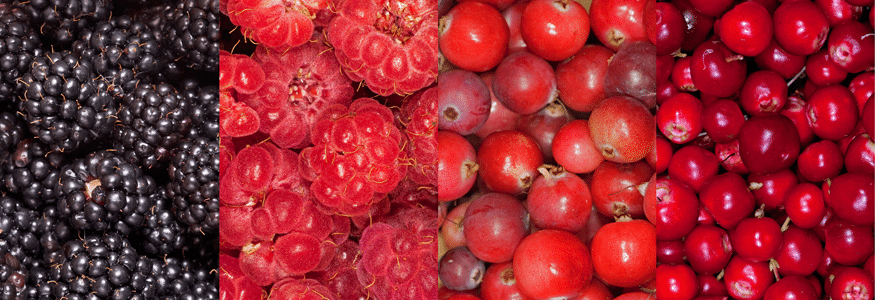
Berries: Bursting With Health Benefits
The health benefits of berries are plentiful. These small, versatile fruits come in many varieties and forms, making it easy to incorporate them into your diet year round. Did you know that Canada is the second largest producer and exporter of blueberries in the world, after the US, and that more than 200 species of berries grow in this country?1 Since these fine fruits are indigenous to North America, we naturally edge out other areas of the world in production.
Whether eaten fresh, frozen, dried, or in juice form, berries provide a big dose of important vitamins and minerals that are rich in antioxidants. Often given superstar status for their nutritional content, below we review a few of the many health benefits of these mouth-watering, colourful fruits.
Vitamins and Minerals
You may be surprised to know that approximately one cup of fresh strawberries provides more vitamin C than a small orange! This water-soluble vitamin is necessary for several body processes, including the synthesis of collagen – a protein found in skin, bones, tendons, and cartilage. Strawberries are also one of the richest natural sources of folate, an essential micronutrient important in health promotion and disease prevention.2
Beta-carotene is a substance naturally present in many fruits, including berries, which can convert into vitamin A in the body (a provitamin). It plays key roles in cell development and immune function. Considering their small size, berries pack a hard punch when it comes to providing the body with important nutrients. This, along with the fact that they are low in calories, makes them a great addition to your daily diet.
Table 16 |
|
| Product with antioxidant content in mmol/100g | |
| Berry, raw | |
| Blackberry | 4.02 |
| Cranberry | 3.29 |
| Raspberry | 2.33 |
| Strawberry | 2.16 |
| Blueberry | 1.85 |
| Gooseberry | 1.45 |
| Juice | |
| Fruits & Berries | 1.69 |
| Grape Blend | 1.62 |
| Cranberry | 1.00 |
| Cran-Apple | 0.71 |
| Berries, dried | |
| Goji berries | 4.31 |
| Cranberries | 1.64 |
| Blueberries | 1.32 |
Table 2 |
|
| Fibre (g) per 100 g | |
| Raspberry | 6.5 |
| Blackberry | 5.3 |
| Cranberry | 4.6 |
| Gooseberry | 4.3 |
| Blueberry | 2.6 |
| Strawberry | 2.2 |
Antioxidants
Antioxidants are substances (e.g., beta-carotene, lycopene, vitamins A, C, and E) that reverse oxidation (see sidebar), which is associated with aging, inflammation, and the development of such conditions as cancer, heart disease, and arthritis.3 Berries, along with other fruits, vegetables, legumes, nuts, and whole grains, all contain some form of antioxidant. The type of berry, climate and soil conditions during growth, degree of ripeness, and the method of processing all affect the antioxidant level in a specific berry.4
The Department of Nutrition at the University of Oslo in Sweden created an Antioxidant Food Database listing the total antioxidant capacity of many fruits, vegetables, beverages, spices, and herbs. They procured samples from countries worldwide and determined their total antioxidant content using a method known as the ferric reducing ability of plasma (FRAP) assay. Table 1 lists the results of some of the berries and berry products. The average antioxidant content of berries and berry products ranked high compared to the other food groups studied.5
Fibre
Dietary fibre can help to control blood sugar (glucose) levels, avoid constipation, reduce some symptoms of irritable bowel syndrome, maintain a healthy body weight, and avert diverticular disease. Berries, both in fresh and dried form, are a very good source of fibre. Including a serving of berries each day will help you reach the recommended daily fibre intake of 25-38g. (See Table 2.)
With all of their water removed, dried berries have an extended shelf life. They are also higher in calories, carbohydrates, fibre, and other nutrients per serving compared to their fresh counterparts.7 This is important to keep in mind if you are trying to lose weight or if you are monitoring your sugar intake. One downside of dried fruits is that processing destroys their water-soluble vitamins (e.g., B and C), although many manufacturers do add these nutrients back in at the end, so read the label to be sure.
In fact, reading the labels on products is a good habit, and doing so when selecting fruit juices could guide you to varieties containing added vegetables, omega 3s, fibre, calcium, and probiotics, making them healthier options over other products. It’s also good to look for juices with no added sugar.
Berries really do live up to all their hype. They are delicious, versatile, packed full of vitamins and minerals, and a good source of fibre. When incorporated into a balanced diet, these juicy fruits contribute to a healthy body and a healthy digestive tract. Eat them often and enjoy their wide-ranging benefits!
Oxidation & Antioxidants
Oxidation is a chemical reaction that occurs during regular cellular processes, such as metabolism and inflammation. It increases with exposure to environmental toxins such as pollution, cigarette smoke, ultraviolet rays, strenuous exercise, and alcohol use. Simply put, oxidation creates highly reactive, unstable molecules (free radicals) which can cause DNA damage and destruction of cells and tissues. Antioxidants are substances that prevent and manage these free radicals and their damaging effects. The body produces its own antioxidants, but external sources help aid in the body’s defense. Although Health Canada has not set a recommended dietary allowance for antioxidants, following Canada’s Food Guide will ensure a balanced diet that includes a variety of foods and beverages, including those containing antioxidants. Be sure to speak with your health care provider before taking any supplements that boast antioxidant claims.
Want to learn more about nutrition?
Read our article on colourful foods, or view our page about Nutrition Month in Canada.

